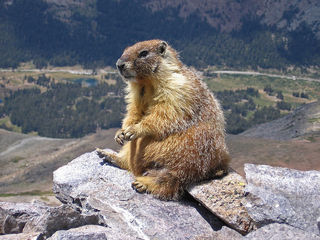
Yellow-bellied marmot
Order : Rodentia
Suborder : Sciurognathi
Family : Sciuridae
Subfamily : Sciurinae
Species : Marmota flaviventris
Keywords: yellow
The Yellow-bellied marmot is listed as Least Concern (LR/lc), lowest risk. Does not qualify for a more at risk category. Widespread and abundant taxa are included in this category, on the IUCN Red List of Threatened Species
Some facts about the
Yellow-bellied marmot
Adult weight : 3.5 kg (7.7 lbs)
Maximum longevity : 21 years
Female maturity :730 days
Male maturity : 730 days
Gestation : 30 days
Weaning : 33 days
Litter size : 4
Litters per year : 1
Interval between litters : 458 days
Weight at birth : 0.034 kg (0.0748 lbs)
Weight at weaning : 0.479 kg (1.0538 lbs)
Basal metabolic rate : 9 W
Body mass : 4.295 kg (9.449 lbs)
Temperature : 36.85 °C (98.33 °F)
Facts about the yellow-bellied marmot
A Yellow Bellied Marmot is seen on a spring morning near Jones Hole and Green River in Dinosaur National Monument between Dinosaur, Colorado and Vernal, Utah.
         Marmota flaviventris is yellow-brown in color with yellow or orange russet bellies.
Burt, Grossenheider 92) Yellow-bellied marmots are found sitting on boulders .
Closely related to the eastern United States' groundhog or woodchuck, the yellow-bellied marmot is common in rocky areas up to about 12,000 feet.
Description of Species: Yellow-bellied marmots are rodents rather similar to squirrels, only bigger.
Interesting Facts:Yellow-bellied marmots are only found west of the Great Plains.
The rockchuck or yellow bellied marmot, Marmota flaviventris, is found throughout the western United States and can be found in a variety of environments from desert to mountain.
The yellow-bellied marmot (Marmota flaviventris ) is a heavy-bodied marmot.
The yellow-bellied marmot (Marmota flaviventris) is a highly social member of the ground squirrel family.
The yellow-bellied marmot is a heavy-set, brown to grizzled animal with white areas on the chin and (as the name suggests) a yellowish belly.
The yellow-bellied marmot is also much more gregarious than the woodchuck, preferring to remain in colonies rather than live a solitary life.
The Yellow-bellied Marmot is very closely related to the groundhog that is common in the eastern United States.
Yellow Bellied Marmot is a 'pest' (an unwanted organism) that can be controlled through the use of pesticides.
Yellow-bellied marmots are generalist herbivores.
Yellow-bellied marmots are the best studied marmot species.
The yellow-bellied marmot, Marmota flaviventris, is a large (five to ten pound) rodent that occurs throughout much of the western United States and in parts of southwestern Canada. (Full text)
The yellow-bellied marmot (Marmota flaviventris) is a favorite animal to many alpine visitors. (Full text)
robertwgross12-30-2004, 07:15 PMYellow-bellied marmot (Marmota flaviventris) is a member of the squirrel family that lives high in the mountains and seldom poses for photographers. (Full text)
Yellow-bellied marmots are rodents rather similar to squirrels, only bigger. (Full text)
The Yellow-bellied Marmot is from the order Rodentia. (Full text)
Yellow-bellied marmots are among the largest rodents, and they also have one of the longer periods of hiberation, something like 6 months. (Full text)
Yellow-bellied marmots are the best studied marmot species. (Full text)
and Ammospermophilus leucurus) are controlled for collection, importation and possession; (xxx) Red squirrel or chickaree, except for nuisance animals, which are noncontrolled for collection, Sciuridae Family (Tamiasciurus hudsonicus) are controlled for collection, importation and possesion; (xxxi) Yellow-bellied marmot, Sciuridae Family, (Marmota flaviventris) is controlled for collection, importation and possesion; (Full text)
The yellow-bellied marmot (Marmota flaviventris) is one of them. (Full text)
More animals beginning with Y
